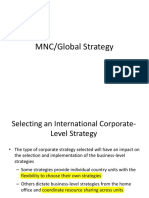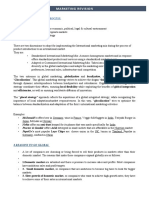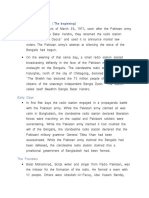INB 301 - Chapter 13 - The Strategy of International Business
INB 301 - Chapter 13 - The Strategy of International Business
Uploaded by
S.M. YAMINUR RAHMANCopyright:
Available Formats
INB 301 - Chapter 13 - The Strategy of International Business
INB 301 - Chapter 13 - The Strategy of International Business
Uploaded by
S.M. YAMINUR RAHMANCopyright
Available Formats
Share this document
Did you find this document useful?
Is this content inappropriate?
Copyright:
Available Formats
INB 301 - Chapter 13 - The Strategy of International Business
INB 301 - Chapter 13 - The Strategy of International Business
Uploaded by
S.M. YAMINUR RAHMANCopyright:
Available Formats
Chapter 13
The Strategy of International Business
What Is Strategy?
• A firm’s strategy refers to the actions that managers take to attain the goals of the firm
• Firms need to pursue strategies that increase profitability and profit growth
• Profitability is the rate of return the firm makes on its invested capital
• Profit growth is the percentage increase in net profits over time
• To increase profitability and profit growth, firms can
• add value
• lower costs
• sell more in existing markets
• expand internationally
What Is Strategy?
Determinants of Enterprise Value
How Is Value Created?
• Profits can be increased by
1. Using a differentiation strategy
• adding value to a product so that customers are willing to pay more for it
2. Using a low cost strategy
• lowering costs
How Can Firms Increase Profits Through International Expansion?
• International firms can
1. Expand their market
• sell in international markets
2. Realize location economies
• disperse value creation activities to locations where they can be performed most efficiently and
effectively
3. Realize greater cost economies from experience effects
• serve an expanded global market from a central location
4. Earn a greater return
• leverage skills developed in foreign operations and transfer them elsewhere in the firm
What Types of Competitive Pressures Exist in the Global Marketplace?
• Firms that compete in the global marketplace face two conflicting types of competitive pressures
• the pressures limit the ability of firms to realize location economies and experience effects, leverage
products, and transfer skills within the firm
• Dealing with both pressures is challenging
• Two competitive pressures:
1. Pressures for cost reductions
• force the firm to lower unit costs
2. Pressures to be locally responsive
• require the firm to adapt its product to meet local demands in each market
• but, this strategy can raise costs
When Are Pressures for
Cost Reductions Greatest?
• Pressures for cost reductions are greatest
1. In industries producing commodity type products that fill universal needs (needs that exist when the tastes
and preferences of consumers in different nations are similar if not identical) where price is the main
competitive weapon
2. when major competitors are based in low cost locations
3. where there is persistent excess capacity
4. where consumers are powerful and face low switching costs
When Are Pressures for
Local Responsiveness Greatest?
• Pressures for local responsiveness arise from
1. Differences in consumer tastes and preferences
• strong pressure emerges when consumer tastes and preferences differ significantly between countries
2. Differences in traditional practices and infrastructure
• strong pressure emerges when there are significant differences in infrastructure and/or traditional
practices between countries
3. Differences in distribution channels
• need to be responsive to differences in distribution channels between countries
4. Host government demands
• economic and political demands imposed by host country governments may require local responsiveness
Which Strategy Should a Firm Choose?
• There are four basic strategies to compete in international markets
• the appropriateness of each strategy depends on the pressures for cost reduction and local responsiveness
in the industry
Which Strategy Should a Firm Choose?
Four Basic Strategies
Which Strategy Should a Firm Choose?
1. Global standardization - increase profitability and profit growth by reaping the cost reductions from
economies of scale, learning effects, and location economies
• goal is to pursue a low-cost strategy on a global scale
• This strategy makes sense when
• there are strong pressures for cost reductions and demands for local responsiveness are minimal
2. Localization - increase profitability by customizing goods or services so that they match tastes and
preferences in different national markets
• This strategy makes sense when
• there are substantial differences across nations with regard to consumer tastes and preferences and cost
pressures are not too intense
3. Transnational - tries to simultaneously achieve low costs through location economies, economies of scale,
and learning effects
• firms differentiate their product across geographic markets to account for local differences and foster a
multidirectional flow of skills between different subsidiaries in the firm’s global network of operations
• This strategy makes sense when
• both cost pressures and pressures for local responsiveness are intense
4. International – take products first produced for the domestic market and sell them internationally with only
minimal local customization
• This strategy makes sense when
• there are low cost pressures and low pressures for local responsiveness
How Does Strategy Evolve?
• An international strategy may not be viable in the long term
• to survive, firms may need to shift to a global standardization strategy or a transnational strategy in
advance of competitors
• Localization may give a firm a competitive edge, but if the firm is simultaneously facing aggressive
competitors, the company will also have to reduce its cost structures
• would require a shift toward a transnational strategy
How Does Strategy Evolve?
Changes in Strategy over Time
You might also like
- International Business: by Charles W.L. HillDocument29 pagesInternational Business: by Charles W.L. HillAshraful IslamNo ratings yet
- Tema 5 International Business PDFDocument33 pagesTema 5 International Business PDFBlah BlamNo ratings yet
- The Strategy of International Business: Mcgraw-Hill/IrwinDocument37 pagesThe Strategy of International Business: Mcgraw-Hill/IrwinMardhiah RamlanNo ratings yet
- Chapter 13 Stratagy of IB.Document26 pagesChapter 13 Stratagy of IB.Exam statusNo ratings yet
- IB Session 6Document11 pagesIB Session 6Pulokesh GhoshNo ratings yet
- Strategy of IB Chapter 13Document26 pagesStrategy of IB Chapter 13Exam statusNo ratings yet
- The Strategy of International BusinessDocument29 pagesThe Strategy of International Businessrittik sarkerNo ratings yet
- The Strategy of International Business - Part2 - 2022 - 10 - 20Document17 pagesThe Strategy of International Business - Part2 - 2022 - 10 - 20samnoh1243No ratings yet
- 2S Global Strategy 5Document6 pages2S Global Strategy 5Faizan UllahNo ratings yet
- International Business: Opening Case: Wal-MartDocument6 pagesInternational Business: Opening Case: Wal-MartSunail HussainNo ratings yet
- International Business Strategy - 24Document17 pagesInternational Business Strategy - 24nahlp22408caNo ratings yet
- International StrategyDocument34 pagesInternational StrategymanicatewatiaNo ratings yet
- Chapter 6 SVDocument51 pagesChapter 6 SVMinh ChâuNo ratings yet
- Competing in Foreign MarketsDocument36 pagesCompeting in Foreign MarketsJo AnnNo ratings yet
- IFIS Lecture 3 Headquarter Subsidiary RelationDocument28 pagesIFIS Lecture 3 Headquarter Subsidiary RelationinkmytaskNo ratings yet
- Chap 11 - IBDocument17 pagesChap 11 - IBkamaruljamil4No ratings yet
- PowerPoint Lecture 8Document40 pagesPowerPoint Lecture 8hrleenNo ratings yet
- PowerPoint Lecture 8Document40 pagesPowerPoint Lecture 8hrleenNo ratings yet
- Chapter 7 - Strategies For Competing in International Market - Draft1Document20 pagesChapter 7 - Strategies For Competing in International Market - Draft1Milky Umar Bawazier100% (1)
- Chapter 5 - International Business StrategyDocument32 pagesChapter 5 - International Business Strategykhanhan231204No ratings yet
- International Business Level StrategiesDocument47 pagesInternational Business Level StrategiesPurnajit CNo ratings yet
- Chap 13Document6 pagesChap 13khanhnguyenfgoNo ratings yet
- Chapter 5 - International Business StrategyDocument33 pagesChapter 5 - International Business StrategyHoàng Trần ĐứcNo ratings yet
- Pressures For Global IntegrationDocument16 pagesPressures For Global IntegrationMahpuja JulangNo ratings yet
- IB-Strategic Options For MNC: Sumit Mitra Iimk 2013-14Document17 pagesIB-Strategic Options For MNC: Sumit Mitra Iimk 2013-14Venkata TummalaNo ratings yet
- He Strategy of International BusinessDocument30 pagesHe Strategy of International BusinessMd. Mehedi HasanNo ratings yet
- The Strategy of International BusinessDocument27 pagesThe Strategy of International BusinessGaurav SinghNo ratings yet
- MBS 3rd Semester International BusinessDocument135 pagesMBS 3rd Semester International BusinessfierceaadarshaNo ratings yet
- Chapter 12 - The Strategy of International BusinessDocument13 pagesChapter 12 - The Strategy of International BusinessVictorie BuNo ratings yet
- Advanced Strategic Management and Globalization: Muhammad Atiq (PHD)Document39 pagesAdvanced Strategic Management and Globalization: Muhammad Atiq (PHD)Zakir KhattakNo ratings yet
- Strategic Management - Post Mid NotesDocument21 pagesStrategic Management - Post Mid Notesmridulrathi4No ratings yet
- Chapter 7 - Strategies For Competing in International Markets 2Document27 pagesChapter 7 - Strategies For Competing in International Markets 2Charmaine RosalesNo ratings yet
- Formulating Long-Term Objectives and Grand StrategiesDocument40 pagesFormulating Long-Term Objectives and Grand StrategiesGandhesNo ratings yet
- Chapter 5 - StrategyDocument48 pagesChapter 5 - Strategynguyenvithaonhi1004No ratings yet
- TL BS C3 Ib CLC 2024Document3 pagesTL BS C3 Ib CLC 2024gbao2003No ratings yet
- S.4 Strategic FormulationDocument74 pagesS.4 Strategic FormulationRonish BanjaraNo ratings yet
- Business - Competitive Level StrategiesDocument14 pagesBusiness - Competitive Level StrategiesGuest HouseNo ratings yet
- Strategy in Global EnvironmentDocument15 pagesStrategy in Global EnvironmentAmit Yadav100% (1)
- Strategic ManagementDocument33 pagesStrategic Managementapi-3741610No ratings yet
- Strategies For Competing in Foreign MarketsDocument30 pagesStrategies For Competing in Foreign MarketsBrucie McstickinsNo ratings yet
- International Competitive StrategyDocument18 pagesInternational Competitive Strategydrlov_20037767No ratings yet
- Day 06Document33 pagesDay 06Jorge PachasNo ratings yet
- Unit - 3Document144 pagesUnit - 3Manikandan SuriyanarayananNo ratings yet
- MAN010 - MODULE 5 - PPT - Multinational Strategies and Structure - NEWDocument36 pagesMAN010 - MODULE 5 - PPT - Multinational Strategies and Structure - NEWHannah NolongNo ratings yet
- Module 6Document54 pagesModule 6Soumya KesharwaniNo ratings yet
- Chapter IVDocument32 pagesChapter IVSudhir Bogati100% (1)
- Strategic Marketing 5Document10 pagesStrategic Marketing 5VikasNo ratings yet
- International Strategic ManagementDocument59 pagesInternational Strategic ManagementAvioliaPutriMediantiNo ratings yet
- INTERNATIONAL MARKEITNGUNIT 4Document6 pagesINTERNATIONAL MARKEITNGUNIT 4shaikh hamidNo ratings yet
- Converting Global Presence Into Global Competitive AdvantageDocument14 pagesConverting Global Presence Into Global Competitive AdvantageKool Bhardwaj100% (1)
- Competing in Global MarketsDocument38 pagesCompeting in Global MarketsjitukrNo ratings yet
- International Strategy: Swati VisputeDocument13 pagesInternational Strategy: Swati VisputekrishmashahNo ratings yet
- 8 Reasons To Go GlobalDocument7 pages8 Reasons To Go GlobalMaryam Fellous MelnykNo ratings yet
- International Management MGT-303-iiiDocument34 pagesInternational Management MGT-303-iiiDr. Anisur RehmanNo ratings yet
- 6.5 Global Marketing R and DDocument32 pages6.5 Global Marketing R and DBiniam AbayNo ratings yet
- The Strategy of International BusinessDocument35 pagesThe Strategy of International Businessenikma.aeNo ratings yet
- Global Product Development: Click To Edit Master Title StyleDocument31 pagesGlobal Product Development: Click To Edit Master Title StyleChienny HocosolNo ratings yet
- ELEN03B Module 7.0Document14 pagesELEN03B Module 7.0Sayy CruzNo ratings yet
- International Strategy WipDocument17 pagesInternational Strategy WipsiddharthbhargavaofficialNo ratings yet
- Dealing with Darwin (Review and Analysis of Moore's Book)From EverandDealing with Darwin (Review and Analysis of Moore's Book)No ratings yet
- Price: Price Decision of Savlon Soap BarDocument2 pagesPrice: Price Decision of Savlon Soap BarS.M. YAMINUR RAHMANNo ratings yet
- INB 301 - Chapter 15 - Entry Strategy and Strategic AlliancesDocument26 pagesINB 301 - Chapter 15 - Entry Strategy and Strategic AlliancesS.M. YAMINUR RAHMANNo ratings yet
- INB 301 - Chapter 8 - Foreign Direct InvestmentDocument16 pagesINB 301 - Chapter 8 - Foreign Direct InvestmentS.M. YAMINUR RAHMANNo ratings yet
- INB 301 - Chapter 4 - The Cultural Environment Facing BusinessDocument20 pagesINB 301 - Chapter 4 - The Cultural Environment Facing BusinessS.M. YAMINUR RAHMANNo ratings yet
- Chap 4 MCQDocument9 pagesChap 4 MCQS.M. YAMINUR RAHMANNo ratings yet
- INB 301 - Chapter 2 & 3 - National Differences in Political Economy and Economic DevelopmentDocument22 pagesINB 301 - Chapter 2 & 3 - National Differences in Political Economy and Economic DevelopmentS.M. YAMINUR RAHMANNo ratings yet
- Short Review On PaapDocument4 pagesShort Review On PaapS.M. YAMINUR RAHMANNo ratings yet
- New Microsoft Word DocumentDocument6 pagesNew Microsoft Word DocumentS.M. YAMINUR RAHMANNo ratings yet
- Swadhin Bangla BetarDocument6 pagesSwadhin Bangla BetarS.M. YAMINUR RAHMANNo ratings yet
- The Title of The Book IsDocument3 pagesThe Title of The Book IsS.M. YAMINUR RAHMANNo ratings yet
- Assignment-02 (Part-02) : Inspection and Taking NotesDocument3 pagesAssignment-02 (Part-02) : Inspection and Taking NotesS.M. YAMINUR RAHMANNo ratings yet
- Ora 11 JonDocument4 pagesOra 11 JonS.M. YAMINUR RAHMAN100% (1)
- Guerrilla Is A Bangladeshi Film Based On The Events of TheDocument5 pagesGuerrilla Is A Bangladeshi Film Based On The Events of TheS.M. YAMINUR RAHMANNo ratings yet
- Ethiopia's New SEZ ProclamationDocument6 pagesEthiopia's New SEZ ProclamationHagos GebreamlakNo ratings yet
- Leadership CrisisDocument2 pagesLeadership CrisisRPNo ratings yet
- Chapter 3 (Marketing Management)Document31 pagesChapter 3 (Marketing Management)LeenaNo ratings yet
- Sources of FundsDocument26 pagesSources of FundsTahir DestaNo ratings yet
- Bims ChalanDocument1 pageBims Chalannoah87619No ratings yet
- Research Note 2 - Sukuk Al Ijarah PDFDocument10 pagesResearch Note 2 - Sukuk Al Ijarah PDFNajib Hj DamitNo ratings yet
- BLR-211 (Final Examination) : Exam ProperDocument48 pagesBLR-211 (Final Examination) : Exam ProperJoshua LokinoNo ratings yet
- Limited Liability Partnership NotesDocument28 pagesLimited Liability Partnership NotesPraveen Kumar DuggalNo ratings yet
- ECO02H Macroeconomics Syllabus (2023)Document13 pagesECO02H Macroeconomics Syllabus (2023)Nguyễn Diệu LinhNo ratings yet
- MAS TEST With AnswerDocument10 pagesMAS TEST With Answerjoneth.duenasNo ratings yet
- 1st Call For Proposals Terms of Reference - Corrigendum 08.01.2024 Amendment of The Annex 1 Tables 3 4Document27 pages1st Call For Proposals Terms of Reference - Corrigendum 08.01.2024 Amendment of The Annex 1 Tables 3 4michalis petrakosNo ratings yet
- Operations ManagementDocument15 pagesOperations ManagementRifa SadiaNo ratings yet
- Analysis of Hybrid Annuity Model in Construction HEB Cass: Anmol Taneja & Dr. Rosy KalraDocument8 pagesAnalysis of Hybrid Annuity Model in Construction HEB Cass: Anmol Taneja & Dr. Rosy KalraDipak PatelNo ratings yet
- Vignesh A Pledge Report 2021-11-07 01-02-34-03Document2 pagesVignesh A Pledge Report 2021-11-07 01-02-34-03VIGNESH KUMARNo ratings yet
- Shaping The Future of Shared Services Centers: Insights From A Delphi Study About SSC Transformation Towards 2030Document20 pagesShaping The Future of Shared Services Centers: Insights From A Delphi Study About SSC Transformation Towards 2030cicero_ferreira_51No ratings yet
- How To Pass A Prop Firm Challenge 1Document11 pagesHow To Pass A Prop Firm Challenge 1Erik100% (1)
- ACCA Strategic Business Reporting (SBR) Achievement Ladder Step 2 Questions and AnswersDocument8 pagesACCA Strategic Business Reporting (SBR) Achievement Ladder Step 2 Questions and AnswersAdam MNo ratings yet
- Muntindilaw National High School: School Grade Level: Teacher: Learning Area Teaching Date and Time: QuarterDocument7 pagesMuntindilaw National High School: School Grade Level: Teacher: Learning Area Teaching Date and Time: QuarterMaricel EspadillaNo ratings yet
- Global Reinsurers Maintain EquilibriumDocument89 pagesGlobal Reinsurers Maintain EquilibriumgargramNo ratings yet
- CBRE CONSULTANTS Professional PracticeDocument7 pagesCBRE CONSULTANTS Professional PracticeHoney DaveNo ratings yet
- KAMMP SeminarDocument2 pagesKAMMP SeminarRheneir MoraNo ratings yet
- FY24 Q1 Consolidated Financial StatementsDocument3 pagesFY24 Q1 Consolidated Financial StatementsDhanaRajNo ratings yet
- Sanitary CatalogueDocument7 pagesSanitary Catalogueab8125035No ratings yet
- Pma Chapter 2 .Document19 pagesPma Chapter 2 .alisya qistinaNo ratings yet
- Brand Management Unit-1Document12 pagesBrand Management Unit-1Arif QuadriNo ratings yet
- Case Study On PaytmDocument11 pagesCase Study On PaytmNaval KishoreNo ratings yet
- This Study Resource Was: ScopeDocument9 pagesThis Study Resource Was: ScopeajejeNo ratings yet
- Bikaner Data UploadING Template (3)Document24 pagesBikaner Data UploadING Template (3)manu.mohanNo ratings yet
- Chapter 3 Project Selection and Portfolio ManagementDocument10 pagesChapter 3 Project Selection and Portfolio Managementtan lee huiNo ratings yet
- Fsesf Avocado Production Export Business Plan 29.10.2019 PDFDocument59 pagesFsesf Avocado Production Export Business Plan 29.10.2019 PDFHerbert Bushara100% (7)






































































































